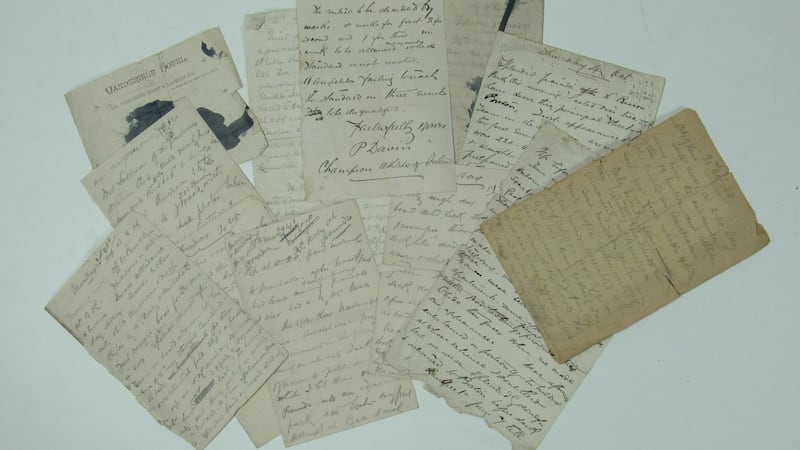More than half the hurlers and athletes who participated in the GAA’s first “junket” to America absconded in New York and failed to return to Ireland.
New information about the famous Gaelic Athletic Association’s “American Invasion Tour” of 1888 has emerged after 128 years in the original diary kept by one of the participants that has come to light.
Pat Davin – a renowned Tipperary athlete from Carrick-on-Suir and brother of Maurice Davin (co-founder and first president of the GAA) – kept the diary during the month-long tour of US cities. The trip was planned to showcase the prowess of Irish athletes and hurlers and to raise funds for a planned revival of the ancient Tailteann Games.

Rare books specialists Fonsie Mealy Auctioneers said Davin's unpublished diary – written on loose sheets of paper including scraps of American hotel stationery – has been consigned to an auction of historical memorabilia by a family descendant of Davin's and will go under the hammer in Dublin on April 23rd. It is expected to sell for up to €6,000. Historic document The diary, described as "a document of the first importance in GAA history", records that the party of hurlers, athletes, officials, a doctor and a priest left Queenstown (now Cobh) aboard the Wisconsin on Sept 16th, 1888, for the nine-day Atlantic crossing.
But, Davin records, when the party boarded the ship City of Rome at New York harbour for the return journey five weeks later, on October 31st, it "sailed away at 2.30 today bearing home the sad remnant of the 53 hurlers and athletes who landed on American soil just five weeks yesterday. Only 24 men returned."
The men’s decision to stay in America is not surprising given the taste of the New World they had experienced during the tour, as vividly chronicled by Davin.
The absconders may also have dreaded the prospect of the return journey across the ocean given Davin’s description of the outward journey when, due to rough weather, “steerage passengers [were] thrown about the deck like dead dogs, men, women and children in heaps together. The hurlers all as sick as blazes with only a few exceptions”.
Among the other passengers aboard were “Germans, Russians, Swedes and an Australian – besides several Yanks – and a girl named Kennedy from Carrick-on-Suir”.
Banquets
Davin provides descriptions of the exhibition hurling matches played in cities including New York, Boston,
Philadelphia
, and Lowell (Massachusetts] during the month-long tour. The group were treated like VIPs to parades accompanied by bands, photoshoots and a series of banquets.
They were hosted by various Irish-American emigrant groups and by US officials including a sheriff and New York's police chief. One of the highlights was "A Grand Reception and Concert" at New York's Tammany Hall where the entertainment was provided by "Bayne's 69th Reg't Band" who played God Save Ireland, The Wearing of the Green and a Virginia Reel (dedicated to the hurlers).
Wicked match
After arriving in America, Davin noted that the first of the hurling exhibition matches took place in New York on Saturday Sept 30th, 1888: “First exhibition of hurling on the
Manhattan
Grounds – about 2,000 people present. Exhibition very good. Wicked match – about 12 hurleys broken”.
Among other highlights in the diary were one dated New York, September 28th: "Hurlers all went to a dance at Gaelic Society in the evening . . . There were over 50 young ladies, very plain-looking ones too – God be with ould Carrick [-on-Suir] and the sky over it . . . the dancing was kept up till 3 in the morning . . . Irish jigs, reels & doubles were freely indulged in . . . many of the ladies were very good at dancing (step-dancing). Their proficiency at this amusement was enough to make one overlook their shortcomings in the matter of good looks."
Another entry for Lowell [Massachusetts] on October 8th, 1888, noted this was “a city as large as Dublin . . . escorted to Polo grounds by band . . . exhibited in a few athletic events and a hurling match won by the ‘Yellow Bellies’ . . . Fair crowd . . . 150 dollars taken. Day bitterly cold many of the lads complained very much of it . . . the goals were almost frozen . . .
“In evening were given a banquet by the Clan-na- Gael society of the place. It was a dry affair no drink except water being visible, though over a score of toasts were proposed – It seems intoxicating liquor of all kinds is forbidden to be sold here or in Lawrence, speech-making very good though the subjects were not interesting to the hurlers . . . to bed at 12-30 swearing legions against attending banquets in future.”










